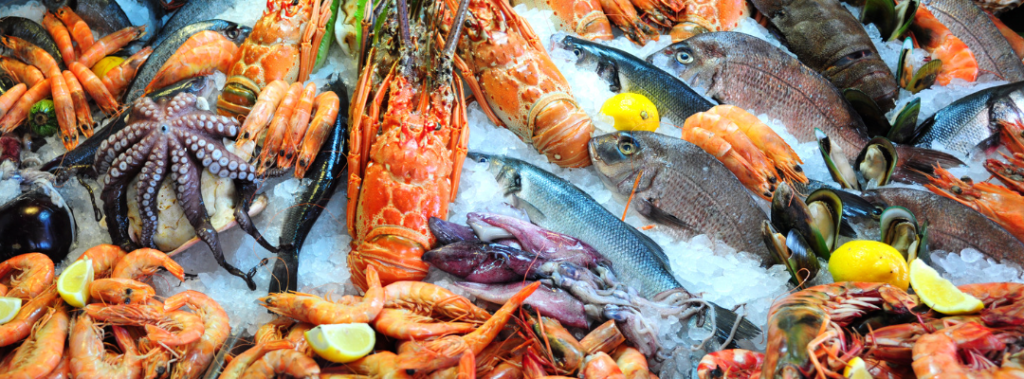
Cold Chain Logistics Can Make or Break Your Frozen Fish
While modern advances to the cold supply chain allows even the most remote places to access temperature sensitive products such as fresh fish, cold chain logistics are far from perfect. Even in the most populated areas, it could take fresh fish three to four days on average to reach the market after it has been caught and stored in a refrigerated warehouse. By the time the consumer gets their hands on the fish, it might be a week old. At that point, it’s a stretch to call the fish “fresh”. The lack of freshness is one of the many reasons consumers may experience low quality fish.
Follow along as we guide you through the process of cold chain logistics.
Water to Market
The fish’s journey to your plate typically begins with a fisher or a fish farm. The fish are then taken to a processing facility, where they are cleaned, chopped, and packaged.
The processed fish is then distributed to wholesalers, restaurants, and retailers. From there, it is sold to customers, either in stores or online. The customers can then cook and enjoy the fish.
The entire process ensures that the fish is fresh and safe to consume. Each of these businesses is responsible for the quality of their fish themselves, but the quality assurance is left mostly to them as well. However, the processing facilities are required to take samples regularly.
For retailers, the quality assurance has more to do with health code monitoring from state and federal authorities. This includes monitoring the appearance and temperature of incoming fish deliveries as well as maintaining storage temperatures.
Occasionally, government officials will inspect the cold storage warehouse to make sure it meets safety regulations. This may include collecting samples of the stored items and verifying that the storage space is kept clean.
Cold Chain Logistics
Problems can start as early as the fishery. From the moment the fish is caught, the cold chain has to be maintained all the way until it is finally prepared for food. As sensitive as fish is, it also requires a high hygiene standard from all parts of the distribution chain.
Cold chain technologies can be broken in many places: on the way from fishery to processing, from processing to sales businesses, or from business to home. If the temperature of the fish rises too high, the speed of spoiling speeds up. This means that at the end, the business selling the fish is responsible for its quality.
Avoid These Mistakes
As a temperature controlled product, fish requires the upkeep of the cold chain throughout its journey from fishery to consumer. Here are some cost effective notions of what not to do when selecting fish:
- Overstuffing counters is often done intentionally, because a counter full of fish looks more enticing. In reality, the fish closest to the counter’s bottom is usually the safest to eat.
- The date of harvesting and expiration date give a good idea of how long the fish should be usable.
- Sense of smell can help a lot when it comes to choosing fish as well.
The bare minimum for fish food safety should include constant monitoring of the temperature levels and basic food hygiene. Collecting data points multiple times a day allows the business to also build an understanding of what contributes to their waste on the counter. That knowledge in turn helps improve the process for both the business’ and customer’s benefit.
What Does “Low Quality” Mean?
Fish can become low quality when the amount of harmful bacteria rises above an acceptable level of safety. Bacterial populations naturally increase over time, but the growth can be slowed and managed through the use of an effective cold chain. A cold chain is a temperature-controlled supply chain that helps preserve the quality of food and other perishable items. It involves the storage and transportation of goods at a temperature that is below the threshold at which bacteria thrive.
By maintaining the cold chain throughout the process, from the point of production to the point of consumption, the growth of bacteria can be significantly slowed and the quality of the fish can be preserved.
Vacuum packaged fish products are a risk, as they can contain deadly bacteria, which flourishes in oxygen-free areas. Botulism, which is caused by this bacteria, can be fatal. The good news is that both listeria and botulism can be destroyed by cooking the fish.
The amount of time a fish product can be stored varies depending on the type of fish and how it was processed. Some filets can only be stored for a short period of time, such as a week, while other products may be usable for an extended period, such as ten days.
The Benefits of a Warehousing Service
There are countless advantages to using a warehouse service to accompany your cold storage logistics. Not only are warehouse services a good way to reduce the wait for deliveries, but it’s also a good way to find affordable fulfillment options. This can take a lot of the groundwork off of the operations team.
It can help with this by outsourcing the types of warehousing you need. If you need a better way to manage your cold storage logistics, finding a cold storage facility that handles the product packaging and processing for you is a good way to start.
Utilizing warehouse services makes it much simpler to control stock in storage facilities and optimize logistics. This facilitates a higher level of productivity and efficiency, as well as allowing quicker turnover of goods.
It can also help with improving customer satisfaction and product accessibility. Businesses can also expect additional benefits when using U.S. cold storage options for their cold supply chain by considering;
- Cold room storage
- Energy efficient temperature range
- Better customer service
- Better inventory management processes
- Capability to keep up with in-demand products and product changes
- Assurance of regularly supplied and managed frozen foods
- Reduction in delayed orders
- Added services



